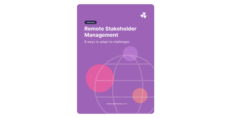Improving Stakeholder Engagement: How to Keep People Engaged

Have you ever been in a situation where you have a solid consultation plan for a project, put a lot of effort into getting it going, but you can’t seem to get people interested? Or perhaps their engagement drops away halfway through the process?
If so, it’s not just you — most stakeholder professionals come across this issue at some point!
So, in case you’re having trouble keeping people engaged, we wanted to share a few lessons and considerations that we’ve picked up over the years that may help.
Find Out Why People Stop Engaging

Firstly, let’s consider what might be driving people away from your consultation so that you can avoid or fix them in future. Here are some possible reasons:
- Irrelevance – You’re consulting on issues that aren’t relevant to the stakeholders
- Poor coordination – Not meeting stakeholder expectations to coordinate with your colleagues so that people don’t get asked the same question over and over
- Consultation fatigue – People are tired of the meetings and questionnaires, and feel like it’s one big consultation event after another
- Limited feedback – If people don’t get feedback on the consultation outcome or hear how their stakeholder participation influenced the outcome, they won’t be motivated to continue
- Failed commitments – You’ve failed to deliver on the commitments made to stakeholders in earlier stages of the consultation
- Inconsistent presence – You lack a continuous presence in the community, only conducting “parachute consultations” and dropping in when you need something
- No follow-up – Little to no follow up means that people won’t know what has happened or what the next steps will be
- Poor communication – Whether you’re engaging people via email, social media, events, phone calls, or some other platform, low quality communication will quickly put people off
- Culturally irrelevant – The consultation timeframe, context, and design don’t take into account the local culture and customs
Of course, there are plenty of other possible reasons people might stop engaging, too. It can be helpful to seek feedback from your disengaged stakeholders to find out any specific contributing factors. And then, of course, take steps to fix any issues that are within your control.
Plan Ahead

Planning is important so you can identify strategies, resources, and timelines that ensure your consultation objectives are met. This could include increasing or maintaining engagement with your stakeholders.
Before beginning a consultation process, ask yourself:
- What are the strategic reasons for consulting with stakeholders?
- Who needs to be consulted?
- What are their priority issues?
- Who is responsible for each activity?
- What is the best way to communicate with stakeholders?
- What other engagement activities will occur in the proposed time frame?
- How will the results be captured, tracked, reported, and disseminated?
If you don’t already have one, create a stakeholder engagement plan that clearly outlines answers to the above key questions. This will not only address some of the issues listed here, but can also help you save time, reduce costs, and keep expectations in check.
Keep It Relevant

Nearly all stakeholder consultations could do a better job of tailoring their engagements to the concerns and interests of their stakeholders.
But in order to do that, you need the right systems and tools in place to assign stakeholder characteristics, analyze your stakeholders, segment them, communicate with them, and track your interactions. That way, you can use past interactions for valuable context that informs your future conversations with stakeholders.
By using a stakeholder engagement tool like Simply Stakeholders, you can do all of that in one place. That way, you and your team can easily share the right information with the right person, at the right time.
Incorporate Stakeholder Feedback

It’s not enough to send out a few surveys to stakeholders and call it a day. Consulting people is like making a promise to them that (at a minimum) their views will be considered throughout the project’s decision making process.
But actually incorporating feedback that looks at a community development’s needs, benefits, and opportunities is well worth doing. It not only increases the success rate of your impact mitigation plans, but also helps to demonstrate your company’s commitments — and that you are acting in good faith.
Of course, it does not mean that every issue or point of feedback must be acted upon. But it does mean that your company should do their best to address key issues through changes to the project design and decisions.
So, consider how you can better incorporate stakeholder feedback into your consultation.
And if there are limitations, challenges, and barriers to meeting stakeholder demands (there nearly always is), be honest and upfront about that. That way, you can manage stakeholder expectations and continue to build trust — even when things don’t go the way your stakeholders want them to.
We’ve previously talked about several examples of incorporating stakeholder feedback in policy engagement as well as the importance of stakeholder feedback for sustainable developments.
Report Back
The final key area to look at when improving your stakeholder engagement is reporting. Many organizations don’t do this step well, but it’s so important to report back to stakeholders throughout the engagement and after the project is finished.
Closing the loop in your stakeholder engagement can help you build trust with stakeholders and show them how their concerns or suggestions have been considered and influenced project decisions. This can help you establish credibility, manage expectations, and reduce consultation fatigue (and cynicism).
And of course, if stakeholders are confident that their voices are being heard and their input can have a genuine impact on outcomes, they’re far more likely to engage with you in future.
Learn More
To sum it up, the two keys to keeping people engaged and improving your engagement really come down to trust and authenticity. People need to trust that your engagement process is genuine, that you listen to their views and opinions, and that their participation contributes to the decision-making process. If you can do that and demonstrate it, your stakeholders will be happy to give you their time and attention.
Become a Subscriber Don’t miss out on more insights like this! Subscribe to get our regular updates.
Want more tips to help improve your stakeholder engagement? Check out these resources:
- Create a Stakeholder Management Plan [Interactive Tool]
- Evaluate Your Stakeholder Engagement [Webinar]
- 7 Strategies for Effective Stakeholder Engagement [eBook]
- 7 Steps to Successful Consultation [eBook]
- Stakeholder Engagement Tips: The Dos and Don’ts [Blog]
- Stakeholder Engagement Best Practices [Blog]






























